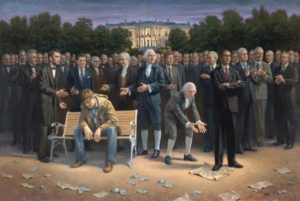
The Forgotten Man
For my paper I will write about “The Forgotten Man” by John McNaughton. With the White House shown in a dreary background, this painting shows 44 U.S. presidents and a distraught young man sitting on a park bench. This painting was made in 2010, after the passage of the Affordable Care Act, and shows two presidents (Bill Clinton and Franklin D. Roosevelt) applauding, while a number of other presidents (Lincoln, Reagan and Washington) show concern for the man on the bench. Meanwhile, President Obama is shown stepping on the U.S. Constitution, while James Madison appears to be trying to save it.
I would like to explore several points about this painting that are very interesting. First, this painting is different from the paintings that Berger shows in Ways of Seeing in that while the old paintings that Berger shows did not have a political message and were often intended to show the wealth of their owners or women as objects, this painting has a clear political purpose to criticize President Obama and wasteful government spending. Also, this painting demonstrates Berger’s point about how using photography to recreate paintings can change their meaning. For example, if the camera focuses on only one part of the painting, such as the presidents who are applauding, instead of showing the whole picture, the message of the painting becomes completely different. This painting is a good example of art that is used for political propaganda purposes, which I find very interesting and different from the paintings in Ways of Seeing.





